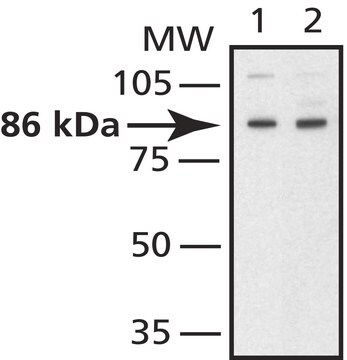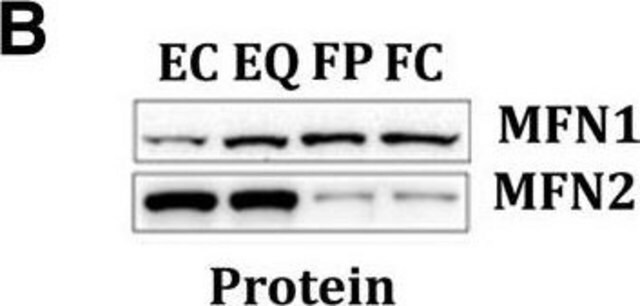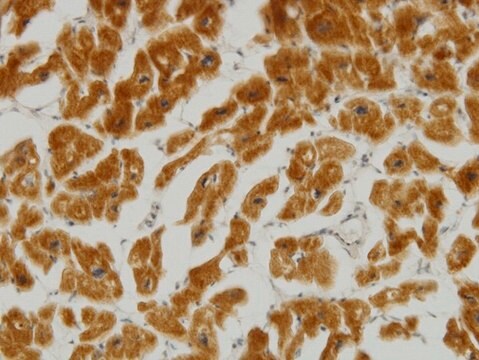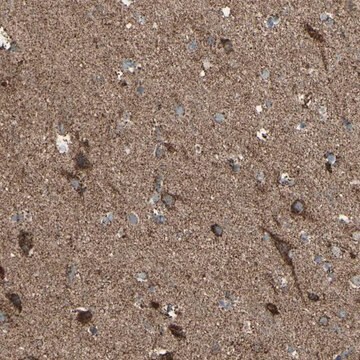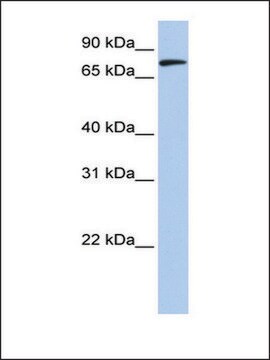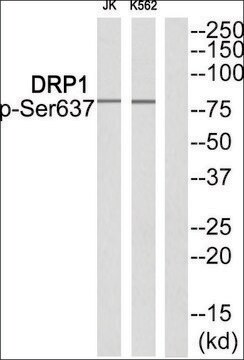Kluczowe dokumenty
M6319
Anti-Mitofusin-2 (N-Terminal) antibody produced in rabbit
affinity isolated antibody, buffered aqueous solution
Synonim(y):
Mitofusin 2 Antibody, Mitofusin 2 Antibody - Anti-Mitofusin-2 (N-Terminal) antibody produced in rabbit, Anti-CMT2A, Anti-CMT2A2, Anti-CPRP1, Anti-KIAA0214, Anti-MARF, Anti-Mfn2
About This Item
Polecane produkty
pochodzenie biologiczne
rabbit
Poziom jakości
białko sprzężone
unconjugated
forma przeciwciała
affinity isolated antibody
rodzaj przeciwciała
primary antibodies
klon
polyclonal
Postać
buffered aqueous solution
masa cząsteczkowa
antigen ~86 kDa
reaktywność gatunkowa
mouse, human, rat
metody
immunoprecipitation (IP): 5-10 μg using HeLa human epitheloid carcinoma cell lysate
indirect immunofluorescence: 20-30 μg/mL using differentiated mouse C2 cells
western blot (chemiluminescent): 0.5-1 μg/mL using extracts of rat or mouse brain mitochondria
numer dostępu UniProt
Warunki transportu
dry ice
temp. przechowywania
−20°C
docelowa modyfikacja potranslacyjna
unmodified
informacje o genach
human ... MFN2(9927)
mouse ... Mfn2(170731)
rat ... Mfn2(64476)
Opis ogólny
Specyficzność
Immunogen
Zastosowanie
By immunoblotting, a working antibody concentration of 0.5-1 mg/mL is recommended using an extracts of rat and mouse brain mitochondria and a chemiluminescent detection reagent.
By indirect immunofluorescence, a working antibody concentration of 20-30 mg/mL is recommended using differentiated mouse C2 cells.
5-10 mg of the antibody immunoprecipitates mitofusin 2 from HeLa human epithelioid carcinoma cell lysate.
Western Blotting (1 paper)
Postać fizyczna
Oświadczenie o zrzeczeniu się odpowiedzialności
Nie możesz znaleźć właściwego produktu?
Wypróbuj nasz Narzędzie selektora produktów.
produkt powiązany
Kod klasy składowania
12 - Non Combustible Liquids
Klasa zagrożenia wodnego (WGK)
WGK 1
Temperatura zapłonu (°F)
Not applicable
Temperatura zapłonu (°C)
Not applicable
Certyfikaty analizy (CoA)
Poszukaj Certyfikaty analizy (CoA), wpisując numer partii/serii produktów. Numery serii i partii można znaleźć na etykiecie produktu po słowach „seria” lub „partia”.
Masz już ten produkt?
Dokumenty związane z niedawno zakupionymi produktami zostały zamieszczone w Bibliotece dokumentów.
Nasz zespół naukowców ma doświadczenie we wszystkich obszarach badań, w tym w naukach przyrodniczych, materiałoznawstwie, syntezie chemicznej, chromatografii, analityce i wielu innych dziedzinach.
Skontaktuj się z zespołem ds. pomocy technicznej